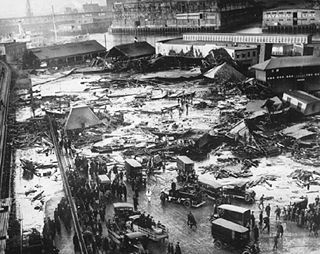 Been kind of busy lately. Also got ingested by, of all things, a book. Yes, it’s true — I found time to read. (Well, actually, I don’t have the time, which is why there is light blogging and a pile of dishes in the sink. But I digress).
Been kind of busy lately. Also got ingested by, of all things, a book. Yes, it’s true — I found time to read. (Well, actually, I don’t have the time, which is why there is light blogging and a pile of dishes in the sink. But I digress).
It’s Dark Tide: The Great Boston Molassas Flood by Stephen Puleo.
I’m not going to recommend this book because I know that history isn’t a lot of people’s bag. But ever since I was a kid, this story fascinated me. Come to think of it, I’ve have a "thing" for historical American disasters: the Johnstown flood (David McCullough’s book on the subject is one of the best history books I’ve read), the Titanic, and the subject of Dark Tide — the Great Boston Molassas Flood of 1919.
I think I first read about the Great Molassas Flood as a child, in a Ripley’s Believe-It-Or-Not cartoon. 21 people died — either crushed by buildings which were flattened by the massive surge, or by asphyxiating in the gooey liquid.
Every so often, I would try to find a book on the subject. A few years ago, I searched in earnest, only to discover that there was no single book on the subject (only a handful of random articles in old history magazines). Sometime last year, I discovered that somone recently wrote an entire book on the subject — Dark Tide. It’s been sitting on my shelf for a while, and I finally opened it.
The story has intrigued me for a number of reasons. For one thing, the idea of a molassas flood is, well, kind of funny (not the fact that 21 people died, of course, but the flood itself). But I also wondered why. I mean, I knew a storage tank burst, and that caused over 2 million gallons of molassas to spill into the North End of Boston at 35 mph (that’s two tons of pressure per square foot). But why was molassas being stored there in the first place?
As it turns out, molassas is a by-product of sugar kane (it’s what’s left when you extract the sugar), and this particular molassas was used for munitions. Fermented, it contains ethanol. So the tank was built to capitalize on World War I.
And it was built rather hastily. Because of time pressures, the tank was never properly tested (by filling it with water). It noticibly leaked since its construction, and for several years (children in the neighborhood would often collect the molassas from the ground in cans); the company’s response was to paint the tank — changing it from green to brown, making the "tears" dripping from the tank less noticeable.
The book is also an intruiging look at the era and its politics. The country was in the midst of a flood of a different type — a flood of immigrants. The Boston’s North End, once a stronghold for Irish immigrants, was transitioning into an Italian neighborhood (like it is today) as the Irish people assimilated and moved up the social chain (including the Fitzgeralds, grandparents of the Kennedys). It was also the time of great social upheaval, with anarchists (including Italians) bucking against the capitalist system and the greedy corporate fatcats. It was the time of Leopold and Loeb, and socialists in the IWW (in fact, the corporate owners of the tank, as well as much of the public, were quick to blame the tank’s rupture on an anarchist’s bomb — this turned out not to be the case).
Anyway, it’s a fascinating little piece of American history that few people know about. And that’s why I haven’t been blogging.

